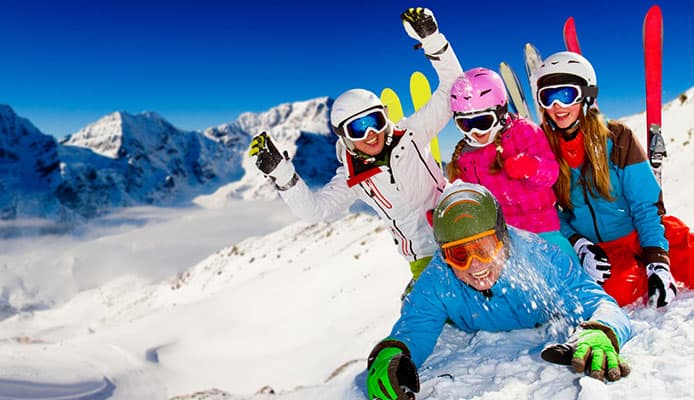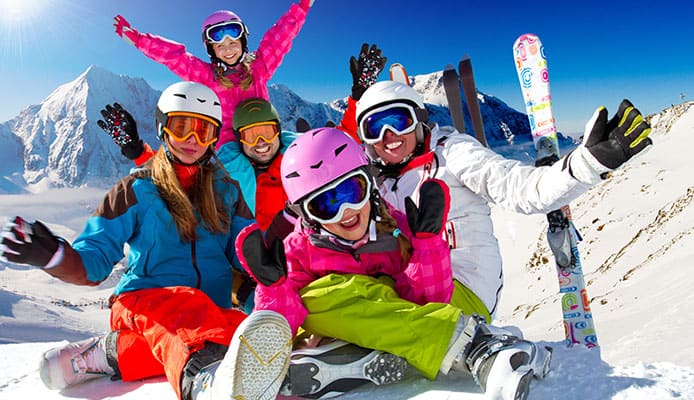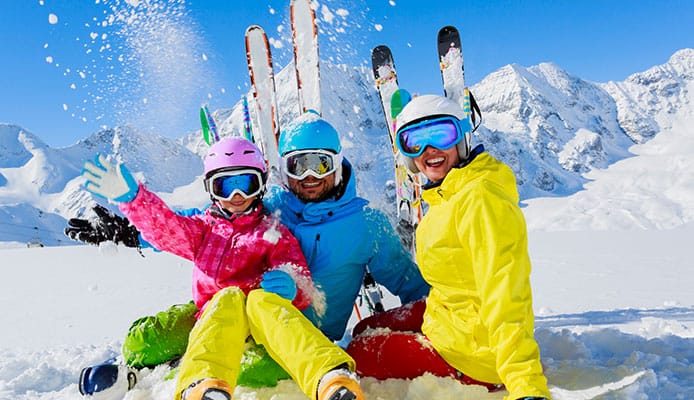
A reliable ski helmet is perhaps the most important piece of equipment you need on the snow – it’s the one thing that might literally save your head. This is why you should invest in a good ski helmet before thinking about other gear. Regardless of whether you’re a beginner on the skis or an experienced skier, you should think about your own safety because accidents can happen when you least expect them to.
As with other ski gear, there are many different types of ski helmets available, and not all of them give you the same level of protection or comfort. Factors like construction, materials used, design, and additional features all need to be considered if you want to find the most efficient ski helmet.
Our buying guide will try to give you some pointers on what to look for, so you have an easier time finding out what suits you best. In addition, the helmets we picked out are safe, stylish, and come with many useful features, so be sure to take a look.
OUR TOP PICK
Smith Optics Holt
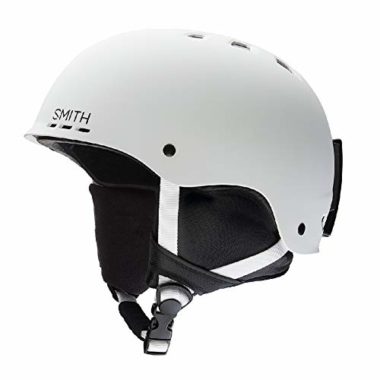
- Stand Out Features - Why We Love It
- AirEvac airflow system
- Compatible with Skullcandy audio system
- Fantastic safety features
- Customizable and removable padding
- Removable ski goggles clip
Shell: ABS
Weight: 19oz
Vents: 14, AirEvac system
Warranty: Limited lifetime warranty
Safety certification: ASTM F2040, CE EN1077:2007, CPSC
EDITORS CHOICE
WildHorn Outfitters Drift
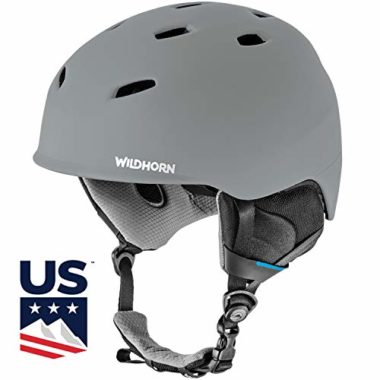
- Stand Out Features - Why We Love It
- Active ventilation VNT system
- Adjustable fit
- Removable ear pads
- Ear pads are audio-compatible
- Ergonomic design
Shell: Polycarbonate In-Mold
Liner: EPS
Weight: 18oz
Warranty: Limited lifetime warranty
Safety certification: ASTM F2040, CE EN1077
BEST VALUE
Retrospec Traverse H1 Convertible
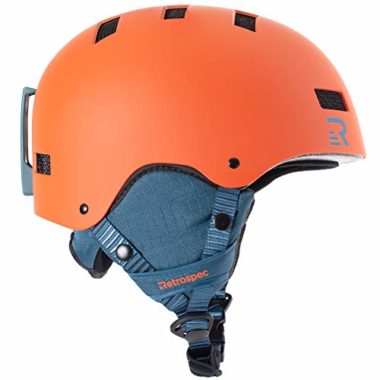
- Stand Out Features - Why We Love It
- ErgoKnob dial for adjusting the fit
- Padded and adjustable chin strap
- Plush fleece padding
- Removable ear pads
- Goggle clip
Shell: ABS
Liner: EPS
Vents: 10 vents
Warranty: 1-year warranty
Safety certification: CE EN1077:2007
OutdoorMaster KELVIN
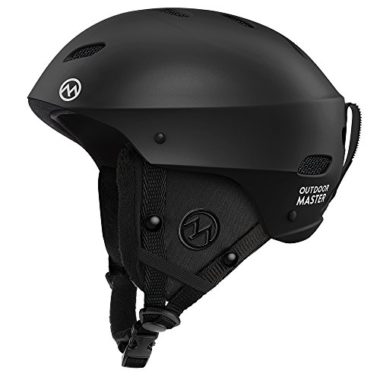
- Stand Out Features - Why We Love It
- Reinforced shell
- Dial for adjusting the fit
- Airflow channels
- Many individual air vents
- Ear pads and fleece liner removable and washable
- High quality safety features
Shell: ABS
Liner: EPS
Weight: 21oz
Vents: 14 vents
Warranty: 1-year warranty
Safety certification: ASTM F2040
AKASO Climate Control Safety-Certified
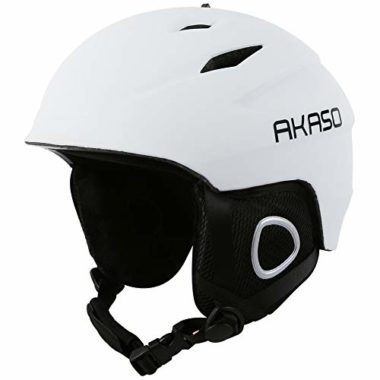
- Stand Out Features - Why We Love It
- Vents can be opened and closed
- Goggle compatible with goggle loop
- Removable ear pads
- Removable and washable inner fleece padding
- Dial for adjusting the fit
Shell: Polycarbonate In-Mold
Liner: EPS
Warranty: Limited lifetime warranty
Safety certification: ASTM F2040, CE EN1077
Gonex Men, Women & Young
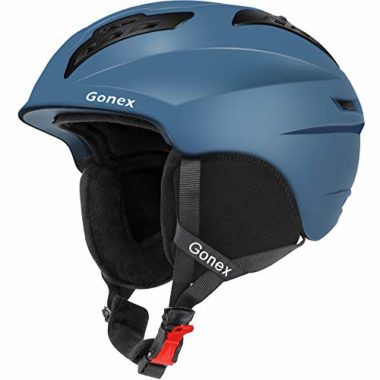
- Stand Out Features - Why We Love It
- Anti-bacterial padding
- Removable ear muffs
- Removable and washable padding
- Clip for securing ski goggles
- Size-adjustment dial
Shell: Polycarbonate In-Mold
Liner: EPS
Weight: 14.4oz (M), 16.1oz (L)
Vents: 8 (4 on top, 4 in the back)
Warranty: 1-year warranty
Safety certification: ASTM F2040-11
Smith Optics Zoom Junior
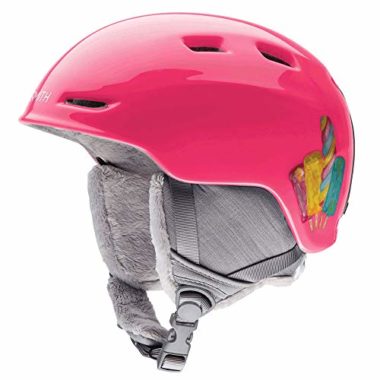
- Stand Out Features - Why We Love It
- Fantastic for children
- Beautiful color options
- Incredibly lightweight
- Adjustable fit
- AirEvac 2 ventilation system
- High quality safety features
Shell: Polycarbonate In-Mold
Liner: EPS
Weight: 11.5oz
Warranty: Lifetime warranty
Safety certification: ASTM F 2040, CE EN1077:2007
Giro Ledge Snow
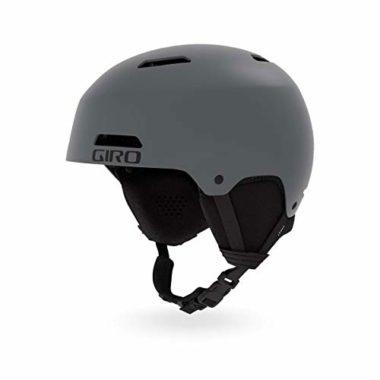
- Stand Out Features - Why We Love It
- Audio-compatible ear pads
- Removable goggle clip and ear pads
- Self-adjusting Auto Loc 2 fit system
- Vertical tuning
- Stack Vent feature to prevent goggle fogging
Shell: Hardshell
Liner: EPS
Warranty: Limited lifetime warranty
Safety certification: CE EN1077
Zionor Lagopus H1
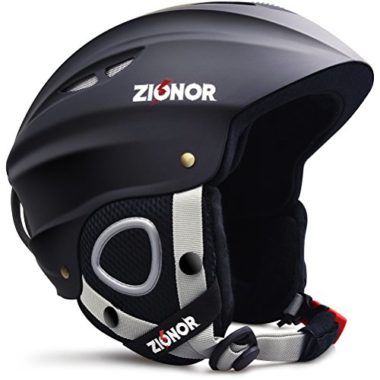
- Stand Out Features - Why We Love It
- Dual airflow evacuation
- Vents can be opened and closed
- Dial for adjusting the fit
- Padded adjustable chin strap
- Breathable and warm inner padding
- High quality safety features
Shell: Polycarbonate In-Mold
Liner: EPS
Safety certification: CE EN1077
Lucky Bums Snow Sport
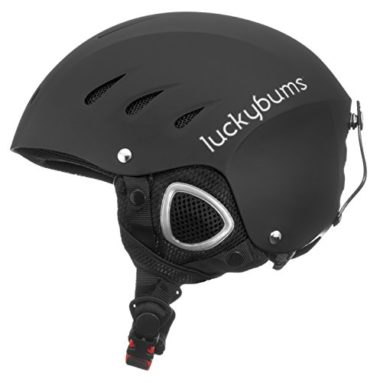
- Stand Out Features - Why We Love It
- Hypoallergenic and antibacterial padding
- Vents with mesh screens
- Ski goggles clip in the back
- Padded chin strap
- Numerous color options
Shell: ABS
Liner: EPS
Weight: 19.2oz
Warranty: Limited lifetime
Safety certification: CE EN1077
How To Choose The Best Ski Helmets – Buying Guide
Buying the top helmet for skiing really isn’t that difficult as long as you keep a few things in mind. The most important thing is safety of course – a helmet’s job is to protect your head if you happen to crash. Because of this, it needs to be really well-made, both in terms of design and materials used.
In addition, the helmet needs to be the right size and have a good fit on your head so it can work properly. After these things are covered, you should also consider how comfortable it feels on your head and all the neat additional features you get with it.
Safety
Keeping your head protected is the main task of any helmet. You may end up in a dangerous situation (often not by your own fault), and a good helmet can really make a difference between serious injury and going away unscathed. Of course, there are many different manufacturers and models on the market, and not all of them are going to give you the level of protection you would expect.
This is why complying with some safety standards when manufacturing a helmet can be a great pointer on whether or not the helmet is good enough for your snow adventures. The most common standards you’ll find in ski helmets are the ASTM (American Society of Testing and Materials) F2040 and the CEN (Common European Norm) EN1077.
Even though they are basically very similar, the first one is used for helmets manufactured and sold in the US market, while the other one is for the European market. As you’ve had the chance to see, all the products we featured are in compliance with one (or both) of these standards. We want to add that these safety standardizations apply for both adult and kids helmets.
All this being said, a helmet isn’t indestructible by any chance. They guarantee to give you a certain level of protection in some situations, but you still need to be responsible and alert. A helmet can prevent a potential injury, so we advise you always to wear one, regardless of whether you are an experienced skier or just learning how to ski.
Construction
The way a helmet is made can somewhat determine how it performs and how it generally feels on your head. The two common types are a hard-shell helmet and an injection-molded (in-mold) helmet. There are also helmets that combine the two, getting the best out of both.
Hardshell helmets have a shell that is made of strong ABS plastic and then fixed (usually glued) to the foam lining. This type is very strong but it’s also heavier and the connection between the shell and the lining isn’t exactly precise. Furthermore, it’s usually bulkier than the other type. However, hardshell helmets are generally more affordable and, for this reason, a more popular choice among recreational skiers.
In-mold helmets have a polycarbonate shell that is precisely molded and then fused to the foam lining. This type of construction gives you a much lighter helmet, often with more vents and better breathability. It also has less bounce on impact, which can be a big plus when discussing safety. The shell itself is significantly thinner and has a nicer shape. On the other hand, this type of helmet is usually a bit more expensive. However, because of their lightweight and versatility, these are popular among backcountry skiers and often have a place on the backcountry gear list.
Finally, there are so-called hybrid helmets that combine both methods to make the helmet strong and resilient but also reduce its weight as much as possible. In any case, the most efficient helmet is the one that meets the safety requirements and feels comfy on your head, but it’s always useful to know the difference between these two construction methods.
Shell
The shell of your helmet is the first barrier that absorbs the impact when you hit your head. As the first line of defense, it needs to resist the strength of the impact. As we mentioned in the previous section, the shell is usually made of ABS (Acrylonitrile butadiene styrene) thermoplastic polymer, or polycarbonate thermoplastic polymer.
ABS is tough, strong, and very resistant to impacts. It won’t crack easily and absorbs much of the force when you hit a sharp or hard object. However, since it doesn’t crack easily it “bounces” some of the shocks which aren’t always desirable. On the other hand, a polycarbonate shell is thinner but also makes for a great protective layer. It cracks when you hit it hard but it’s able to absorb most of the shock so your head remains completely safe.
Buying a helmet made of high-quality materials has many benefits – not only does it guarantee that your head stays safe, but you also get a more durable product that is going to last for a longer time before it needs replacing.
Shock-absorbing Liner
The shell we discussed isn’t going to give you the needed protection on its own. The shock-absorbing liner that lies underneath is at least equally important. Without it, the helmet loses much of its efficiency. Most types of helmets have some form of a liner (motorcycle, bicycle, skateboard).
The material that is most commonly used as a liner is EPS (Expanded Polystyrene). This is a type of hard foam that resembles styrofoam, and its main function is to absorb the shock that is transferred from the shell so it doesn’t reach your head. It does that by getting compressed on the point of impact.
An added bonus of EPS liners is that they also help retain heat inside the helmet and keep your head warm. Manufacturers are constantly trying to make changes and improve these liners, and make the helmets more efficient by doing so.
Padding
One of the main things that determine how comfortable a helmet feels on your head is the padding inside it. Also, this is one of the bonuses of owning your own helmet. The padding is often removed in rental helmets (having everybody sweating on it isn’t exactly sanitary), but having a nice padded helmet feels great.
This inner padding is often made of synthetic fleece or a material with similar properties. Its job isn’t only to feel comfy on your head, but also to help retain heat and to wick moisture. For breathability purposes, this inner lining often combines fleece with mesh windows that allow the air to circulate and the vents to be more efficient.
In some helmets, paddings are made of hypoallergenic materials, which prevents the material from irritating your scalp after a whole day of wearing the helmet (even if you get sweaty). Furthermore, some materials have an anti-microbial treatment that helps reduce the number of bacteria and consequently reduces the odors in the helmet.
Size and Fit
Properly sizing a new helmet is a very important step when buying. We’re not talking just about comfort, but mainly about helmet efficiency. A good helmet shouldn’t be too large or too small if you want it to work as it should. As you had the chance to see, ski helmets come in many different sizes, based on the head circumference. Manufacturers usually specify this number in centimeters, so you can measure your head and see if it’s the right one for you.
We advise that you pay attention to this and measure properly. You do this by taking a measuring tape and measuring the circumference of your head in the area just above your ears and eyebrows (where your head is the widest). This way you’ll get a good idea which helmet size you should get.
If your circumference is near the top number within one size, we advise that you go with a larger size. The reason for this is that you might want to wear a beanie underneath, or the helmet itself doesn’t have the same shape as your head and might feel too tight and uncomfortable.
Many helmet models also allow you to precisely adjust the fit, so it sits on your head even better. Usually, there is a small dial in the back that controls the tightness of the plastic system inside. We think this is a great feature because it allows you to get the most comfortable helmet while staying fully protected. Furthermore, some products have vertical adjustability, which is convenient since it allows you to close a potential gap between the helmet and the goggles for example.
Weight
The weight of your helmet is not the most important thing, at least when it comes to safety. Don’t be fooled – just because a helmet feels heavier doesn’t mean it is going to give you better head protection. However, the weight has much to do with comfort, and how good or bad a helmet feels after wearing it the whole day. This is determined by the type of construction and the materials used to make it. As we mentioned earlier, in-mold helmets are generally lighter than hard shells.
Most products we featured in our helmet reviews range somewhere between 15 and 20oz, which shouldn’t be a problem or a strain on your neck. A helmet that is too heavy will start to feel tiring after a while and will tempt you to take it off. In addition, a heavier helmet may produce a stronger bounce if you hit your head and potentially cause a neck injury. So, when it comes to this, we would advise that you get the lightest helmet as long as it meets all the necessary safety requirements.
Type
There are several different types of ski helmets you can find on the market. However, a half shell helmet is certainly the most popular one, and the type you’ll most commonly see on the slopes. It’s a helmet that covers your head but not the ears – they are covered with soft and removable ear pads. These low profile ski helmets are more comfortable and give you an option for using them during warmer weather if you remove the pads.
The other two types of ski helmets are the full shell and the full-face helmet. A full shell is similarly designed to a half shell, but instead of having soft ear pads, they have ear covers made from the same tough plastic as the rest of the shell. This type gives you added ear protection, and you’ll often see it on competitors.
The full-face helmet resembles a motorcycle helmet and extends over the jawline to give you face protection too. It is the safest, but it’s also the bulkiest and heaviest. Because of this, you won’t see it that often on ski tracks.
Ventilation
Air circulation in a snow helmet might not be the first thing that comes to mind, but it’s more important than you think. This is why manufacturers pay special attention to ventilation when designing a helmet. Skiing is often a high-energy activity and your head will get sweaty inside the helmet. Allowing some air to circulate keeps the head dry and greatly increases the comfort level.
Well-designed vent systems make the helmet feel much nicer to wear. It’s not just about the number of vents, but also about their positioning and adjustability. The helmet usually draws cold air in through the top and sides as you’re going down the slope, and releases moist warm air through the vents in the back.
Some regular and backcountry helmets have vents that can be opened and closed, so you can adjust whether you want to keep your head warm or to let some air in to cool you down. This usually raises the helmet price and isn’t that important to recreational skiers. However, to those of you who like to put on your all-mountain skis and explore different terrains, this kind of versatility might prove to be very useful.
Ears Covers
As we mentioned earlier, most helmet models are half shells that come with soft ear pads (covers). These are an essential part of your helmet since they keep your ears warm. When you put a helmet on, they should fit snuggly against your head and not let any cold air in. On some helmet models, the ear covers can be removed. This is a plus since it allows you to quickly cool down, and also allows you to use the helmet for skateboarding or cycling during the summer months (when you don’t need the added warmth).
The covers are usually heavily padded and lined with a material that feels nice and soft on your ears. Some models are even audio-compatible – they come with integrated earphones or allow you to put your earphones inside the cover (through a zipper on the ear pad). This is a really nice addition since you can listen to your favorite music while skiing.
Unfortunately, this feature rarely comes by default, and you often need to spend additional money on replacement pads that have this type of compatibility. We also want to point out that you need to be very careful when listening to music, especially in a crowded area. It’s very important to hear what’s happening around you, so this can increase the risk of an accident happening.
Chin Straps
Every helmet requires a chin strap to hold it in place, otherwise, the helmet won’t be able to do its job. Strapping your helmet keeps it from flying off on impact, so be sure to always do this. When it comes to the strap itself, it should be adjustable, so it isn’t too loose or it doesn’t cut in your neck and create discomfort.
An additional plus is if the chin strap is padded because it really increases the comfort. You will come across different types of straps and buckles when browsing helmet models, and which one you choose isn’t that significant. It’s more important that it’s easy to use and that you remember to use it.
You might also like: Women’s Ski Jackets
Ski Goggle Compatibility
Most helmet models you’ll find on the market today are goggle-compatible. This wasn’t always the case, so it’s huge progress. Still, you should make sure that your new helmet and goggles sit neatly next to each other. When you put both on and adjust them, there shouldn’t be any gap in between. This is a way for cold air to come in, which can be really annoying.
On the other hand, the rim of your helmet shouldn’t press down on the goggles either. Pushing them down your nose can be very uncomfortable and also might break the goggle seal which causes fogging up of the goggles. It’s usually the safest bet if you get both the helmet and the goggles from the same manufacturer. However, cross-compatibility between manufacturers is usually very good, so you probably won’t have any problems.
Some additional features a helmet can have are the goggle grooves and a goggle clip in the back. Goggle grooves on the sides keep the straps secure and prevent them from sliding up and down the helmet. The goggle clip is used to secure the strap, so you can safely lift the goggles up on your helmet without the fear of losing them.
MIPS
The MIPS (Multi-directional Impact Protection System) is one of the features designed and implemented to further improve your safety. Basically, helmets equipped with MIPS have an additional inner layer that is able to move independently to the shell, allowing it to absorb and redirect the force without transferring it to the head.
This system is most useful when you hit your head at an angle (instead of straight on) since it helps eliminate the rotational forces that are very harmful to the brain. Many of the ski helmets have this system, and while it’s great if a helmet has it, it does increase the price a bit. In addition to MIPS, you will also come across similar protection systems, but this one is most popular and widespread.
Camera Mounts
Many newer helmet models come with camera mounts, which is a huge plus for all of you who like to record your adventures. It’s a secure spot to attach your GoPro camera (or a GoPro alternative), and you can count on it to hold the camera in place throughout your day on the snow.
If you’ve decided you want to record some video on the slopes, buying one of the snow skiing helmets with a mount is a much better option than installing the mount yourself. While this feature raises the price, it allows you to go out, have fun, and watch it again later.
FAQs
Q: What Is A Ski Helmet?
It’s a helmet specially designed to give you head protection in circumstances you might encounter on the mountain (while skiing on and off-track). As we discussed earlier, it’s made of several different layers with a function of absorbing the force of the impact so your head gets away unharmed.
While this is certainly its main purpose, the best helmets are also comfortable to wear, fit nicely on your head, and are ventilated (allowing your head to breathe). Some even have removable padding which adds versatility so you can use them during other seasons too. However, the main thing is that it’s a necessary piece of equipment you need to have on whenever you step on your skis.
Q: What Size Helmet Should You Choose?
This depends on the size and shape of your head. A helmet needs to fit snuggly on your head – neither too tight nor too loose. Be sure to measure the circumference of your head with a measuring tape and then compare that to the sizing chart (provided by most manufacturers).
If it’s possible, try the helmet on before buying it to see how it fits. If not, be sure to check out the reviews given by other users – these may prove to be really helpful and give you a clearer image of what you can expect. Only once you’ve found the helmet that fits well and your head is protected, you can proceed to look at other gear – ski jackets, ski boots, and other necessary equipment.
Q: How To Clean Ski Helmet?
Cleaning a helmet for skiing isn’t that difficult, requiring only a little effort. It’s even easier if the ear pads and the inner padding are removable. In that case, you can wash them separately, by hand or sometimes even in a washing machine (check the manufacturer’s instructions). This helps remove odors that have formed as a result of sweat and bacteria. If the padding isn’t removable, you can use anti-bacterial sprays specially made for helmets, that will help remove the odors and keep things fresh.
As for the shell of your skiing helmet, you can use helmet cleaners (disinfectants) to clean it both inside and out. If you can’t find these specialized cleaners (or they are too expensive for your taste), you can use other products as long as they are not too aggressive. Sometimes even warm water with mild detergent does the trick. Be careful to use a soft cloth and not a rough sponge so you don’t scratch the helmet surface. Finally, make sure everything is completely dry before storing the helmet between seasons.
Q: How To Store Ski Helmet?
A helmet for skiing isn’t that gentle and storage isn’t a big issue. This being said, you should still avoid keeping it someplace moist, or where it will get bumped often. Keeping it in a dry closet will do the trick just fine. As an added bonus, some ski helmets come in a soft bag or a hard storage case when you buy them. While these aren’t exactly necessary, having them will help additionally protect the helmet.
Q: Is Ski Helmet Necessary?
Yes, it is. There are many solid arguments that outweigh the main argument of not wearing one (discomfort). The most important reason for wearing a helmet is keeping your head safe in a potentially very dangerous situation. In fact, many ski centers have strict rules that demand you wear a helmet at all times.
But you shouldn’t wear a helmet just because someone said so – wear it because it’s an integral part of your own safety on the track. Don’t get too comfortable even if you’re a very good skier. It often happens that somebody else hits you from the back and is responsible for the accident, so wearing a helmet can prove to make a huge difference.
Globo Surf Overview
A high-quality helmet for skiing is perhaps the most important piece of equipment you will buy. It keeps you protected if something unfortunate happens, so you need to be smart when choosing. As we pointed out in the guide, it needs to be well-made and meet all the safety requirements. Additionally, it needs to be properly sized and comfy to wear, otherwise you’re going to be tempted to take it off.
All the ski helmets we reviewed rank very highly in all these main categories and many of them are very stylish too. We’re sure you’ll find the one that suits you perfectly, and when you’ve made your pick you can think about what to wear skiing and buy the remaining ski gear you need for your trip.


